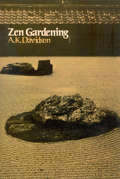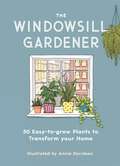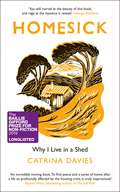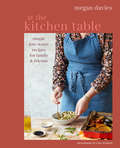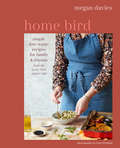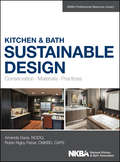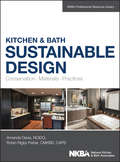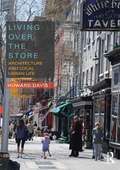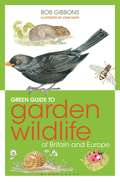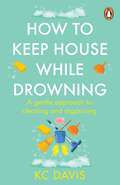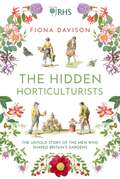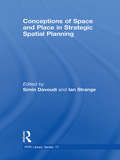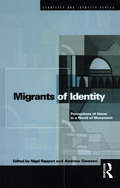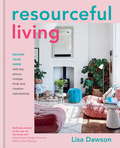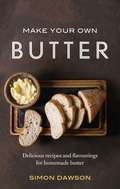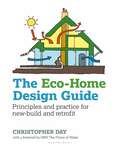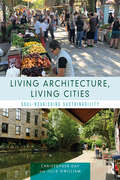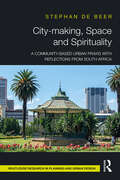- Table View
- List View
Zen Gardening: Muso Soseki In His Gardens (Michigan Monograph Series In Japanese Studies #56)
by A. K. DavidsonThe Zen gardens of Japan are places in which to meditate. They can be anything from a landscaped garden, complete with waterfalls, to a bed of raked pebbles. This ancient way of gardening goes back to the Zen Buddhist priest-gardeners of the thirteenth century. Based on abstract compositions, relying on simplicity and suggestion, their gardens were designed to liberate the imagination, while providing a starting point in the appreciation of everyday things.Zen Gardening is the first handbook to examine the concepts and techniques that make up this garden art and to apply them to the West. It explains the historical relationship between Zen and the development of gardens, and gives practical suggestions for the creation of a Zen garden at home. The chapters on the garden components and their adaptation for the West, principles of design, and construction work, are illustrated with over 150 line drawings. Step by step they show us how to make the most of corners of large gardens, of plots not large enough for lawns and flower beds, or of awkward passageways, alleys and terraces.The principles of Zen gardening are particularly relevant in our crowded conurbations. Keir Davidson's thoughtful and practical approach enables us to maximize our garden space and to create areas of calm in our own immediate environment. Without precedent in the West, his book will be a source of delight to gardeners of every persuasion.
The Windowsill Gardener: 50 Easy-to-grow Plants to Transform Your Home
by Annie DavidsonGrow amazing plants from the comfort of your own home.This book will teach you the basics of growing fruit, vegetables, herbs, and the very best indoor flowers, as well as tips and tricks to reuse your food scraps and reduce your waste as you experiment with seeds.Did you know that you can grow a beautiful houseplant from an avocado seed? Or regrow lettuce in a matter of weeks, just in an inch of water? And you can create a windowsill of delicious herbs simply from cuttings?You don’t need a complicated toolkit to start sowing; just spades of enthusiasm and any spare containers you have lying around your home. And here’s the best part: as your windowsills begin to burst with greenery, you will reap the health benefits too – from anti-oxidants to air purifiers, as well as plants which aid good sleep, your plants will transform every aspect of your lifestyle.This gorgeous book celebrates the joy of creating something from scratch and infusing the home-grown mentality into all aspects of your lifestyle, from your mealtimes to your home décor and your wellbeing. So, just pick up a pot and start sowing your own!
Homesick: Why I Live in a Shed
by Catrina DaviesThe story of a personal housing crisis that led to a discovery of the true value of home.*'You will marvel at the beauty of this book, and rage at the injustice it reveals' George Monbiot**'Incredibly moving. To find peace and a sense of home after a life so profoundly affected by the housing crisis, is truly inspirational' Raynor Winn, bestselling author of The Salt Path*Aged thirty-one, Catrina Davies was renting a box-room in a house in Bristol, which she shared with four other adults and a child. Working several jobs and never knowing if she could make the rent, she felt like she was breaking apart. Homesick for the landscape of her childhood, in the far west of Cornwall, Catrina decides to give up the box-room and face her demons. As a child, she saw her family and their security torn apart; now, she resolves to make a tiny, dilapidated shed a home of her own.With the freedom to write, surf and make music, Catrina rebuilds the shed and, piece by piece, her own sense of self. On the border of civilisation and wilderness, between the woods and the sea, she discovers the true value of home, while trying to find her place in a fragile natural world.This is the story of a personal housing crisis and a country-wide one, grappling with class, economics, mental health and nature. It shows how housing can trap us or set us free, and what it means to feel at home.
Designing Gardens on Slopes
by Elizabeth Davies Ruth ChiversDesigning real gardens on slopes for real people forms the central core of this book. It demonstrates that making plans for gardens on slopes of all types really works. Not only that, they are a necessary part of the process of turning challenging sites into attractive gardens. This is a really useful book that shows how good design helps to avoid costly common mistakes. It is a simple and informative guide detailing from survey to construction and planting. Not many gardens are completely flat. Just one step in a garden makes a big difference, adding more interest to the site. But slopes do present more of a challenge when designing gardens and definitely add to the expense of a building project. A select portfolio of beautifully designed gardens shows projects from start to finish. These are not simply attractive garden plans - they actually work! Not only does this book inspire, it will show how to master hilly sites. There are currently no books that deal specifically with this common problem: in fact, in many books, designing gardens on slopes is barely mentioned. Students of garden design, qualified garden and landscape designers, landscape builders and architects, and owners of sloping gardens will therefore find this book particularly useful.
At The Kitchen Table: Simple, low-waste recipes for family and friends
by Megan DaviesWant to eat well, reduce food and packaging waste and save some money? Home Bird is here to help, going back to basics with seasonal, bold and wholesome recipes that are not only better for the environment but also your well-being and budget.Influenced by nostalgic meals and cooking for loved ones, Megan Davies has written this book for the eco-minded home cook. She includes invaluable tips on how to make ingredients stretch; from potato peel crisps to pickled cucumber and beetroot. Megan also features ways to turn leftovers into a new meal, such as a Roasted Fennel, Chive and Dill Pasta Bake or Frittata, both from a leftover Raw Fennel, Chive and Dill Salad. Recipes include multi-tasking brunch or late-night dishes such as Bircher Pancakes or Sweet Potato Baked Eggs. Suppers for Sharing that can be scaled up to feed a crowd or down for a more intimate occasion range from Roasted Squash with Almonds and Tarragon to the best Roast Chicken recipe with Pan Pastry Croutons (plus, of course, ways to use up any uneaten chicken!). From On the Side accompaniments and stunning Sweet Things such as Pot Luck Tarte Tatin this collection of delicious and ingenious recipes will have all the inspiration you need to run a more sustainable home kitchen, reduce your carbon footprint and make the sort of small changes at home that can make a big difference to our world.
Home Bird: Simple, low-waste recipes for family and friends
by Megan DaviesWant to eat well, reduce food and packaging waste and save some money? Home Bird is here to help, going back to basics with seasonal, bold and wholesome recipes that are not only better for the environment but also your well-being and budget.Influenced by nostalgic meals and cooking for loved ones, Megan Davies has written this book for the eco-minded home cook. She includes invaluable tips on how to make ingredients stretch; from potato peel crisps to pickled cucumber and beetroot. Megan also features ways to turn leftovers into a new meal, such as a Roasted Fennel, Chive and Dill Pasta Bake or Frittata, both from a leftover Raw Fennel, Chive and Dill Salad. Recipes include multi-tasking brunch or late-night dishes such as Bircher Pancakes or Sweet Potato Baked Eggs. Suppers for Sharing that can be scaled up to feed a crowd or down for a more intimate occasion range from Roasted Squash with Almonds and Tarragon to the best Roast Chicken recipe with Pan Pastry Croutons (plus, of course, ways to use up any uneaten chicken!). From On the Side accompaniments and stunning Sweet Things such as Pot Luck Tarte Tatin this collection of delicious and ingenious recipes will have all the inspiration you need to run a more sustainable home kitchen, reduce your carbon footprint and make the sort of small changes at home that can make a big difference to our world.
Kitchen & Bath Sustainable Design: Conservation, Materials, Practices (NKBA Professional Resource Library)
by Amanda Davis Robin Fisher NKBA (National Kitchen and Bath Association)The leading industry association's handbook for going green in the kitchen and bath Kitchen & Bath Sustainable Design is the National Kitchen and Bath Association's complete guide to "greening" these important rooms. The first book to focus exclusively on kitchen and bath sustainability, this full color guide covers every consideration for both remodels and new construction, making it a handy reference for any kitchen and bath professional. Case studies of award-winning projects demonstrate how space, budget, and sustainability can come together to create beautiful, functional, efficient rooms, and illustrations throughout provide visual examples of the techniques discussed. The book includes information on greening one's practice for the client's benefit, plus an appendix of additional resources and instructional materials for classroom use. Outside of general heating and cooling, kitchen appliances use the bulk of a household's energy. Kitchens and baths together use an average of 300 gallons of water per day for a family of four, and both rooms are high-use areas that require good air quality. Kitchen & Bath Sustainable Design provides a handbook to designing these rooms for sustainability, without sacrificing comfort or livability. With comprehensive guidance on approaching these rooms sustainably, readers will: Communicate better with builders, clients, and potential clients Understand technical considerations, and the criteria that make a design "green" Conduct a full design analysis, including life cycle costing and efficiency Learn the ratings systems and standards in play in the green kitchen and bath The biggest elements of sustainable interior design—energy efficiency, water use, and materials selection—are all major players in the kitchen and bath. Clients are increasingly demanding attention to sustainability issues, and designers must be up to date on the latest guidelines, best practices, and technology. Kitchen & Bath Sustainable Design is the complete technical and practical guide to green design for the kitchen and bath professional.
Kitchen & Bath Sustainable Design: Conservation, Materials, Practices (NKBA Professional Resource Library)
by Amanda Davis Robin Fisher NKBA (National Kitchen and Bath Association)The leading industry association's handbook for going green in the kitchen and bath Kitchen & Bath Sustainable Design is the National Kitchen and Bath Association's complete guide to "greening" these important rooms. The first book to focus exclusively on kitchen and bath sustainability, this full color guide covers every consideration for both remodels and new construction, making it a handy reference for any kitchen and bath professional. Case studies of award-winning projects demonstrate how space, budget, and sustainability can come together to create beautiful, functional, efficient rooms, and illustrations throughout provide visual examples of the techniques discussed. The book includes information on greening one's practice for the client's benefit, plus an appendix of additional resources and instructional materials for classroom use. Outside of general heating and cooling, kitchen appliances use the bulk of a household's energy. Kitchens and baths together use an average of 300 gallons of water per day for a family of four, and both rooms are high-use areas that require good air quality. Kitchen & Bath Sustainable Design provides a handbook to designing these rooms for sustainability, without sacrificing comfort or livability. With comprehensive guidance on approaching these rooms sustainably, readers will: Communicate better with builders, clients, and potential clients Understand technical considerations, and the criteria that make a design "green" Conduct a full design analysis, including life cycle costing and efficiency Learn the ratings systems and standards in play in the green kitchen and bath The biggest elements of sustainable interior design—energy efficiency, water use, and materials selection—are all major players in the kitchen and bath. Clients are increasingly demanding attention to sustainability issues, and designers must be up to date on the latest guidelines, best practices, and technology. Kitchen & Bath Sustainable Design is the complete technical and practical guide to green design for the kitchen and bath professional.
Living Over the Store: Architecture and Local Urban Life
by Howard DavisThe shop/house – the building combining commercial/retail uses and dwellings – appears over many periods of history in most cities in the world. This book combines architectural history, cross-cultural understandings and accounts of contemporary policy and building practice to provide a comprehensive account of this common but overlooked building. The merchant's house in northern European cities, the Asian shophouse, the apartment building on New York avenues, typical apartment buildings in Rome and in Paris – this variety of shop/houses along with the commonality of attributes that form them, mean that the hybrid phenomenon is as much a social and economic one as it is an architectural one. Professionals, city officials and developers are taking a new look at buildings that allow for higher densities and mixed-use. Describing exemplary contemporary projects and issues pertaining to their implementation as well as the background, cultural variety and urban attributes, this book will benefit designers dealing with mixed-use buildings as well as academics and students.
Living Over the Store: Architecture and Local Urban Life
by Howard DavisThe shop/house – the building combining commercial/retail uses and dwellings – appears over many periods of history in most cities in the world. This book combines architectural history, cross-cultural understandings and accounts of contemporary policy and building practice to provide a comprehensive account of this common but overlooked building. The merchant's house in northern European cities, the Asian shophouse, the apartment building on New York avenues, typical apartment buildings in Rome and in Paris – this variety of shop/houses along with the commonality of attributes that form them, mean that the hybrid phenomenon is as much a social and economic one as it is an architectural one. Professionals, city officials and developers are taking a new look at buildings that allow for higher densities and mixed-use. Describing exemplary contemporary projects and issues pertaining to their implementation as well as the background, cultural variety and urban attributes, this book will benefit designers dealing with mixed-use buildings as well as academics and students.
Working Cities: Architecture, Place and Production
by Howard DavisCities have historically supported production, commerce, and consumption, all central to urban life. But in the contemporary Western city, production has been hidden or removed, and commerce and consumption have dominated. This book is about the importance of production in the life of the city, and the relationships between production, architecture, and urban form. It answers the question: What will cities be like when they become, once again, places of production and not only of consumption? Through theoretical arguments, historical analysis, and descriptions of new initiatives, Working Cities: Architecture, Place and Production argues that contemporary cities can regain their historic role as places of material production—places where food is processed and things are made. The book looks toward a future that builds on this revival, providing architectural and urban examples and current strategies within the framework of a strong set of historically-based arguments. The book is illustrated in full colour with archival and contemporary photographs, maps, and diagrams especially developed for the book. The diagrams help illustrate the different variables of architectural space, urban location, and production in different historical eras and in different kinds of industries, providing a compelling visual understanding for the reader.
Green Guide to Garden Wildlife Of Britain And Europe (Green Guides)
by John Davis Bob GibbonsAimed at both the general reader and amateur naturalist, this guide offers information on observing and identifying 150 of the species most commonly encountered in gardens of Britain and Europe. Each species' habits, range and important characteristics are described, while colour paintings show each in detail. There are sections on and how to encourage wildlife into your garden and how to watch it. Sound advice on conservation issues is also offered. The book can be used as both a home reference and a pocket companion in the field.
How to Keep House While Drowning: A gentle approach to cleaning and organising
by KC DavisSimple tools to make home care easy when life is hardWhen you are neurodivergent, have undiagnosed ADHD or are struggling with your mental or physical health, keeping on top of the laundry pile and tackling dishes in the sink can feel like climbing a mountain. But it doesn’t have to be that way.Licensed therapist KC Davis has been there. Having relearnt the basics of self-care after an adult diagnosis of ADHD, she is here to revolutionise the way you look after your home and your mind. This gentle guide to staying afloat when life is tough shares practical strategies to create a functional home, make your space work for you rather than against you, and treat yourself with more compassion and kindness.KC’s philosophy: good enough is perfect. With her help, your home will feel like a sanctuary again.‘A kind and understanding book to help us all feel a little better about ourselves and how we live’ Helen Russell, bestselling author of The Year of Living Danishly
The Hidden Horticulturists: The Untold Story of the Men who Shaped Britain’s Gardens
by Fiona Davison'Delightful... The Hidden Horticulturists pulsates with the extraordinary energy and excitement of the time.' Daily MailChosen as one of the Sunday Telegraph's 'Top Ten Gardening Books of the Year' _____________________The untold story of the remarkable young men who played a central role in the history of British horticulture and helped to shape the way we garden today.In 2012, whilst working at the Royal Horticultural Society's library, Fiona Davison unearthed a book of handwritten notes that dated back to 1822. The notes, each carefully set out in neat copperplate writing, had been written by young gardeners in support of their application to be received into the Society's Garden.Amongst them was an entry from the young Joseph Paxton, who would go on to become one of Britain's best-known gardeners and architects. But he was far from alone in shaping the way we garden today and now, for the first time, the stories of the young, working-class men who also played a central role in the history of British horticulture can be told.Using their notes, Fiona Davison traces the stories of a selection of these forgotten gardeners whose lives would take divergent paths to create a unique history of gardening. The trail took her from Chiswick to Bolivia and uncovered tales of fraud, scandal and madness - and, of course, a large number of fabulous plants and gardens. This is a celebration of the unsung heroes of horticulture whose achievements reflect a golden moment in British gardening, and continue to influence how we garden today.
Conceptions of Space and Place in Strategic Spatial Planning (RTPI Library Series)
by Simin Davoudi Ian StrangeBringing together authors from academia and practice, this book examines spatial planning at different places throughout the British Isles. Six illustrative case studies of practice examine which conceptions of space and place have been articulated, presented and visualized through the production of spatial strategies. Ranging from a large conurbation (London) to regional (Yorkshire and Humber) and national levels, the case studies give a rounded and grounded view of the physical results and the theory behind them. While there is widespread support for re-orienting planning towards space and place, there has been little common understanding about what constitutes ‘spatial planning’, and what conceptions of space and place underpin it. This book addresses these questions and stimulates debate and critical thinking about space and place among academic and professional planners.
Conceptions of Space and Place in Strategic Spatial Planning (RTPI Library Series)
by Simin Davoudi Ian StrangeBringing together authors from academia and practice, this book examines spatial planning at different places throughout the British Isles. Six illustrative case studies of practice examine which conceptions of space and place have been articulated, presented and visualized through the production of spatial strategies. Ranging from a large conurbation (London) to regional (Yorkshire and Humber) and national levels, the case studies give a rounded and grounded view of the physical results and the theory behind them. While there is widespread support for re-orienting planning towards space and place, there has been little common understanding about what constitutes ‘spatial planning’, and what conceptions of space and place underpin it. This book addresses these questions and stimulates debate and critical thinking about space and place among academic and professional planners.
Sketching Interiors at the Speed of Thought: - with STUDIO
by Jim Dawkins Jill Pable"Books such as this are imperative for our students to learn skills taught as part of a class. Although this book is geared towards interior design, the content and skills development will be as important to students in garden design and soft furnishings alike." Vicky McClymont, National Design Academy, Nottingham, UKUse detailed, step-by-step techniques to create quick perspective sketches. The book will help you develop important skills for ideation and client communication. Exercises cover a wide range of elements including doors, windows, stairs, millwork, furnishings, and ceilings, as well as more advanced topics like shade and shadowing, scene composition, contrast, and materials and textures.-Interactive digital content, including demonstration videos and self-assessment exercises-Presented in three parts: beginning, intermediate, and advanced sketching techniques-Sketching Gallery shows the work of practitioners allowing you to enhance your stylePLEASE NOTE: Purchasing or renting this ISBN does not include access to the STUDIO resources that accompany this text. To receive free access to the STUDIO content with new copies of this book, please refer to the book + STUDIO access card bundle ISBN 9781501323508.
Migrants of Identity: Perceptions of 'Home' in a World of Movement
by Andrew Dawson Nigel RapportGlobal movement is commonly characterized as one of the quintessential experiences of our age. Market forces, territorial conflicts and environmental changes uproot an increasing number of people, while mass communication, travel, tourism, and a global market of commodities, texts, tastes, fashions and ideologies place individuals more than ever in a global arena. As traditional conceptions of individuals as members of stationary, fixed and separate societies and cultures no longer convince, to what extent does movement become central to individuals' self-conceptions? How do people cultivate, negotiate, nurture and maintain an identity? To what extent do individuals become ‘migrants of identity' whose home is movement?Defining ‘home' as ‘where one best knows oneself', this pioneering book explores the various ways in which people perceive themselves to be ‘at home' in today's world. Through a series of case studies, authors show that for a world of travellers, labour migrants, exiles and commuters, ‘home' comes to be found in behavioural routines and techniques, in styles of dress and address, in memories, myths and stories, in jokes and opinions. In short, people who live their lives in movement make sense of their lives as movement.
Resourceful Living: Revamp Your Home With Key Pieces, Vintage Finds And Creative Repurposing
by Lisa DawsonIt's often thought that restyling your space comes with a hefty price tag and unavoidable waste. But in Resourceful Living, award-winning interiors blogger Lisa Dawson shows how, with a little creativity, you can revamp your home with existing pieces, vintage finds and key purchases. The clever ideas in this beautiful book cover:- The most important ways we use our homes, from eating to sleeping, living and working.- The Basics of steering clear of interiors 'fast fashion', multi-purposing furniture and making the most of what you have.- Styling Your Home with simple solutions for re-imagining each room, from gallery walls to home bars, repainted storage to retro accessories.Including her top ten key vintage buys and tips for in-store and online thrifting, Lisa's inspiring advice shares the fun of creative sourcing as a more sustainable way to keep your home feeling fresh.'Resourceful Living feels like reading a recipe book, not only because of the delicious interiors images, but because of the simple ingredients and easy methods that are shared to achieve beautiful living spaces for yourself.' Melanie Sykes'I've been a long-time fan and follower of Lisa's interiors tips. This book really is super practical as well as beautiful - perfect for anyone looking to be more interiors savvy.' Rachel Khoo
Make Your Own Butter: Delicious recipes and flavourings for homemade butter
by Simon DawsonIf it's fun, funky, jazzy and is to do with butter, it's in this book. From how to make butter at home, to where to use it, and if that raises your 'yeah, sure, I know about butter, pal' eyebrows, this book is going to surprise and delight you into next week.Split into four sections:· What you need to know· Making butter· Getting creative· RecipesMake Your Own Butter will· Whip you into a frenzy so you can't wait to start churning· Thrill and surprise with its sheer range of buttery creations like cocktails and beauty products· Enthral with QI style buttery facts· Equip you with a life skill to be passed on to others
The Eco-Home Design Guide: Principles and practice for new-build and retrofit (Sustainable Building #8)
by Christopher DayThe key principles of designing a pleasant, comfortable and healthy eco-home, with a foreword written by HRH The Prince of Wales, now King Charles III. Designing an eco-home is much more about working with your house's location and situation than relying on intrusive technology and hi-tech materials. With the soaring energy bills and the climate crisis, it is now more important than ever to invest in a home that is considerate of keeping heat in.In this handbook, architect Christopher Day draws on his extensive experience to explain the key principles of eco-home design, using common-sense methods. Packed full of practical information, it includes several case studies of eco-homes, reviewing (with hindsight) what worked well and what could have been better. There is also guidance on how to generate energy, upgrading old buildings, and site planning.With beautifully hand-drawn illustrations, Christopher explores how to use local topography, combined with landscaping, to improve your home's microclimate and keep your house dry and warm in the winter, and cool in the summer. There are also handy tips on how to minimise hidden environmental impacts, and ideas on ways to make your home a safe and healthy place, both emotionally and physically. The Eco-Home Design Guide is essential for anyone who wants to create a attractive, environmentally friendly home that is in harmony with its location.
Living Architecture, Living Cities: Soul-Nourishing Sustainability
by Christopher Day Julie GwilliamIt’s widely accepted that our environment is in crisis. Less widely recognized is that three quarters of environmental damage is due to cities – the places where most of us live. As this powerful new book elucidates, global sustainability is therefore directly dependent on urban design. In Living Architecture, Living Cities Christopher Day and Julie Gwilliam move beyond the current emphasis on technological change. They argue that eco-technology allows us to continue broadly as before and only defers the impending disaster. In reality, most negative environmental impacts are due to how we live and the things we buy. Such personal choices often result from dissatisfaction with our surroundings. As perceived environment has a direct effect on attitudes and motivations, improving this can achieve more sustainable lifestyles more effectively than drastic building change – with its notorious performance-gap limitations. As it’s in places that our inner feelings and material reality interact, perceived environment is place-based. Ultimately, however, as the root cause of unsustainability is attitude, real change requires moving from the current focus on buildings and technology to an emphasis on the non-material. Featuring over 400 high quality illustrations, this is essential reading for anyone who believes in the value and power of good design. Christopher Day’s philosophy will continue to inspire students with an interest in sustainable architecture, urban planning and related fields.
Living Architecture, Living Cities: Soul-Nourishing Sustainability
by Christopher Day Julie GwilliamIt’s widely accepted that our environment is in crisis. Less widely recognized is that three quarters of environmental damage is due to cities – the places where most of us live. As this powerful new book elucidates, global sustainability is therefore directly dependent on urban design. In Living Architecture, Living Cities Christopher Day and Julie Gwilliam move beyond the current emphasis on technological change. They argue that eco-technology allows us to continue broadly as before and only defers the impending disaster. In reality, most negative environmental impacts are due to how we live and the things we buy. Such personal choices often result from dissatisfaction with our surroundings. As perceived environment has a direct effect on attitudes and motivations, improving this can achieve more sustainable lifestyles more effectively than drastic building change – with its notorious performance-gap limitations. As it’s in places that our inner feelings and material reality interact, perceived environment is place-based. Ultimately, however, as the root cause of unsustainability is attitude, real change requires moving from the current focus on buildings and technology to an emphasis on the non-material. Featuring over 400 high quality illustrations, this is essential reading for anyone who believes in the value and power of good design. Christopher Day’s philosophy will continue to inspire students with an interest in sustainable architecture, urban planning and related fields.
City-making, Space and Spirituality: A Community-Based Urban Praxis with Reflections from South Africa
by Stéphan de BeerThis book is about the soul of the city, embodied in its spaces and people. It traces dynamics in inner city neighbourhoods of South Africa’s post-apartheid capital, Pretoria. Viewing the city through its most vulnerable people and places, it recognizes that urban space is never neutral and shaped by competing value frameworks. The first part of the book invites planners, city-makers, and ordinary urban citizens, to consider a new self-understanding, reclaiming their agency in the city-making process. Through the metaphor of "becoming like children", planning practice is deconstructed and re-imagined. A praxis-based methodology is presented, cultivating four distinct moments of entering, reading, imagining and co-constructing the city. After deconstructing urban spaces and discourses, the second part of the book explores a concrete spirituality and ethic of urban space. It argues for a shift from planning as technocracy, to planning as immersed, participatory artistry: opening up to the "genius" of space, responsive to urban cries, and joining to construct new, soul-full spaces. Local communities and interconnected movements become embodiments of urban alternatives – through resistance and reconstruction; building on local assets; animating local reclamations; and weaving nets of hope that will span the entire city. Providing a concrete methodology for city-making that is rooted in a community-based urban praxis, this book will be of interest to urban planning researchers, professional planners and designers and also grass-root community developers or activists.
City-making, Space and Spirituality: A Community-Based Urban Praxis with Reflections from South Africa
by Stéphan de BeerThis book is about the soul of the city, embodied in its spaces and people. It traces dynamics in inner city neighbourhoods of South Africa’s post-apartheid capital, Pretoria. Viewing the city through its most vulnerable people and places, it recognizes that urban space is never neutral and shaped by competing value frameworks. The first part of the book invites planners, city-makers, and ordinary urban citizens, to consider a new self-understanding, reclaiming their agency in the city-making process. Through the metaphor of "becoming like children", planning practice is deconstructed and re-imagined. A praxis-based methodology is presented, cultivating four distinct moments of entering, reading, imagining and co-constructing the city. After deconstructing urban spaces and discourses, the second part of the book explores a concrete spirituality and ethic of urban space. It argues for a shift from planning as technocracy, to planning as immersed, participatory artistry: opening up to the "genius" of space, responsive to urban cries, and joining to construct new, soul-full spaces. Local communities and interconnected movements become embodiments of urban alternatives – through resistance and reconstruction; building on local assets; animating local reclamations; and weaving nets of hope that will span the entire city. Providing a concrete methodology for city-making that is rooted in a community-based urban praxis, this book will be of interest to urban planning researchers, professional planners and designers and also grass-root community developers or activists.
